History of Rowing Victoria Inc
- Table of Contents
- Introduction
- Chapters
- 1: Rowing in a young Victoria 1838-1859
- 2: Formation of the Association 1860-1875
- 3: Growth of the Sport 1876-1889
- 4: Years of great success 1890-1899
- 5: The rise of Australian Henley1900-1909
- 6: The War Years 1910-1919
- 7: Women's rowing and the modern era 1920-1929
- 8: The Depression Rebuild 1930-1939
- 9: War and rebuilding 1940-1949
- 10: Expansion years 1950-1959
- 11: The search for international success 1960-1969
- 12: Combining the Associations and lightweight success 1970-1979
- 13: The new national program 1980-1989
- 14: Golden years 1990-1999
- 15: Professionalism 2000-2009
- 16: Yet More Growth 2010-2019
- 17: Challenging Times 2020-2026
- Appendices
- 1: Life Membership and other important awards
- 2: Patrons and Presidents
- 3: Office Bearers
- 4: Clubs and their histories
- 5: The Oarsmen's Centotaph and WWI Roll of Honour
- 6: WWII Roll of Honour
- 7: Premierships
- 8: State Championships
- 9: Hall of Fame Inductees
- 10: Victorian Olympians
- 11: International representation
- 12: Intercolonial and Interstate Racing
- 13: School rowing
- 14: University rowing
- 15: Histories of Victorian Rowing
- 16: Annual Reports
7. Women's rowing and the modern era 1920-1929
Chapter 7 page 1 2 3 4
This page is under construction.
The social revolution created during the war years continued with even greater speed in 1920s with the Edwardian era differing markedly from the Victorian.
The changes were not just cultural, the economy boomed and housing grew. Governments improved infrastructure with significant expenditure in electricity production, roads and water. The "Roaring Twenties" were great, until late in 1929 when the Great Depression took hold.
From a rowing perspective, both the sport and women's rowing grew, the latter benefitting from the social changes of this era. Women took men's jobs during the war and now there was no turning back. Equality of the sexes took significant steps forward and women's rowing was no exception.
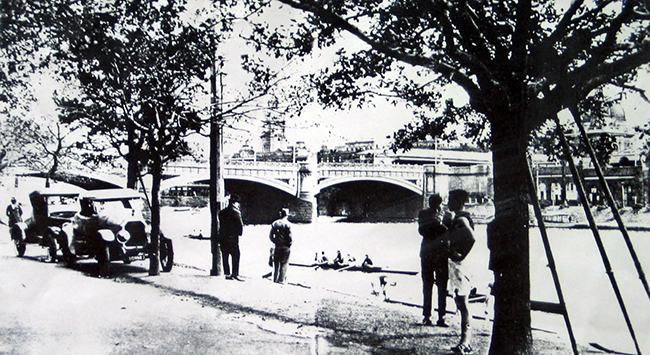
Princes Bridge rowing scene from the 1920s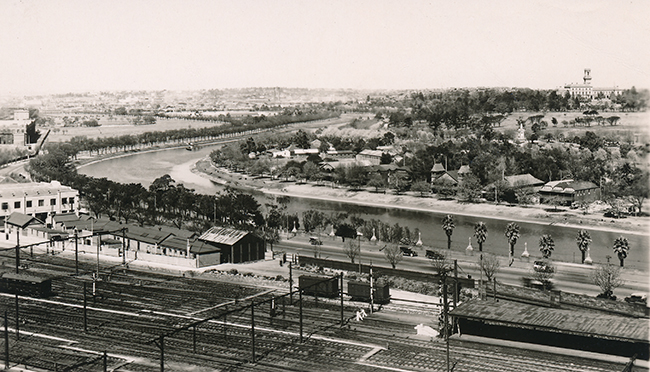
And from the city looking across to the boatsheds and river
1920
The big event for the sport nationally at that time was the recommencement of the men's Interstate Championships after the war. However from a historical perspective, an even bigger event occurred, the first official Interstate Women's Championship, a four.
This first official women's championship was conducted at the same time and place as the men's championships and provided good racing. NSW raced well and took the early lead. The South Australians then put on a great effort to row through the NSW crew and take the lead. The Queensland crew also rowed through the NSW crew to gain level terms with the South Australians. The crews used regulation fours, which were boats with a flat bottom and quite wide.
The South Australians were all from the Mannum Rowing Club with stroke and three seat being sisters. Edna Arnold lived and died in Mannum. Dorothy Arnold lived at Brighton Beach, Victoria and died in 1989 aged 93. As an aside, Dorothy Bertha Arnold, was born 1895 and Edna Alice Arnold born 1897. They were daughters of Johan Georg Arnold, probably the most famous of the paddle steamer builders, operators and repairers on the Murray River, based at Mannum. He was a Swede who skipped Sweden to escape detention after a workers’ strike of which he was a leader, coming to SA in 1899.
Also historically important was the creation of the Australian Women's Rowing Council at this regatta on 13th May 1920. Furthermore, the Queensland United Licensed Victuallers' Association agreed to donate a splendid trophy made from 100 silver guineas to be known as the ULVA trophy but more commonly and affectionately known as "Bertha", presumably after the stroke Dorothy Arnold whose middle name was Bertha. It was a fitting trophy for such an important event.
This trophy is still proudly used today and bears the name the Queen's Cup.
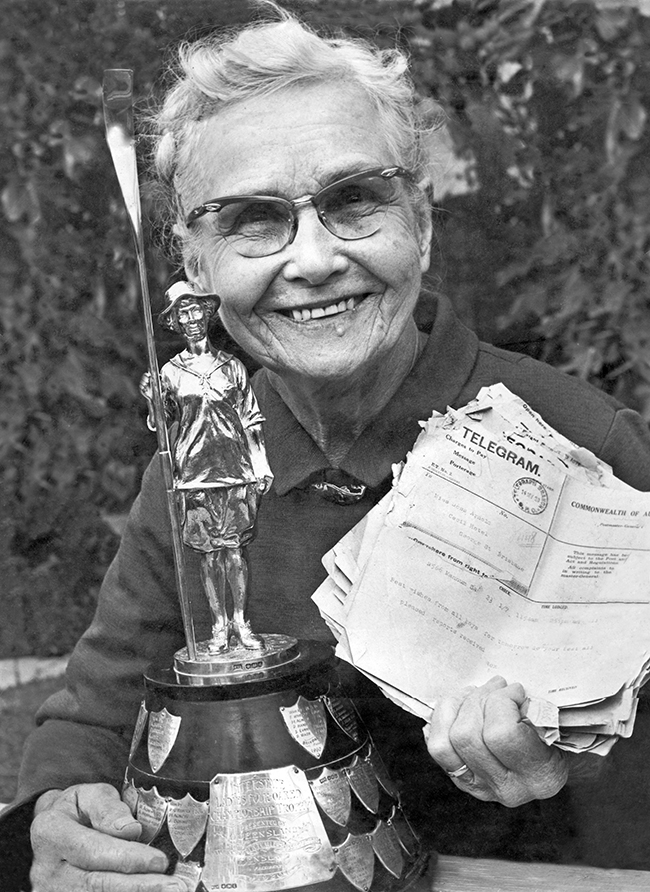
Stroke of the victorious 1920 crew Dorothy Arnold on the 50th anniversary in 1970 with victory telegrams
Some extracts from the Victorian Rowing Association annual report.
Significantly, this season was the first for six years in which a full programme of regattas and championships, including the Interstate races, was held, and it was acknowledged that the standard of racing and competition matched, if not exceeded the record of pre-war rowing. The Nagambie Rowing Club won the coveted Senior Premiership, despite defeat in the champion eight, and the Banks Rowing Club would see success in the junior division.
The season was opened in splendour with combination eight-oared races in October. An impressive entry of 23 crews was received, and the winning crew comprised of athletes from the Banks, Yarra Yarra, Civil Service, Hawthorn, Mercantile and Footscray Rowing Clubs. The trophy for the coxswain winning the most heats was won by Master E Counihan of Mercantile Rowing Club.
After having been suspended for five seasons on account of the war, the class Australian Eight-Oared Championship race was revived, and rowed over the three mile course on the Brisbane River in May. Each of the six states were represented on a day were ideal weather conditions prevailed. South Australia were crowned the winners, with the state of Victoria finishing fifth.
In connection with the revival of this great race, the Queensland Rowing Association permitted an interstate four-oared race to be rowed between ladies’ crews from South Australia, Queensland and New South Wales. The ladies met on the 13th of May and formed the Australian Ladies’ Rowing Council. A letter was written to the Association stating the desire of the Council that the ladies’ Interstate race be rowed annually in conjunction with the Australian Eight-Oared and Sculling Championships. This motion was not favoured by many of the state representative associations for rowing.
The integration of the men's and women's Interstate Championships did not occur regularly until 1976 and the two Associations did not merge until 1980. The eventual fully integration of the two Associations was forced upon the sport by government policy. By the time of integration, most clubs had men's and women's programs and the delay in the integration was due to a variety of reasons including fear of lack of autonomy by the women's Association of being lost in the far larger men's association, loss of some funding when funding had been granted to both the men's and women's arms of effectively the same organisation, and some residual men's clubs reticence of change.
In 1920, both the Victorian men's and women's associations wanted to maintain separate identities and there was no discussion of this possibility. Disappointingly when viewed through the lens of today, the Victorian Rowing Association voted against the women's interstate races being conducted with the men.
Women's rowing in Victoria used the Henley-on-Maribyrnong Carnival as their major race for the year. The Carnival was hosted by the Essendon River League and included both rowing and canoe racing. It received good municipal support which was rewarded by the women later in the decade with the Mayoresses of the municipalities in which the women raced and trained figuring prominently in the new Association as Patrons and Vice-Presidents.
The Henley-on-Maribyrnong Regatta hosted what was regarded by the rowing clubs involved as the first Ladies' Fours Championship.7 It was the first Henley on the Maribyrnong will be held since the outbreak of the war, part of the Essendons’ River League Aquatic Carnival. There were over 40 events taking place over the course of the afternoon. Hundreds of decorated boats and canoes were present. Despite the Victorian Ladies' Rowing Association was not yet formed, this race was also reported as the Championship race. The Championship was conducted on Saturday 14th February 1920 and was won by Albert Park from Bendigo by a canvas. In this season, the crews had won race each prior to this race. The winning crew comprised bow: Miss E Brooks, 2: Miss Lena Partington, 3: Miss R Sullivan, str: Miss F Brooks, cox: unknown. The Bendigo crew comprised bow: Miss Brownlee, 2: Miss Oldfield, 3: Miss Oldfield, str: Miss Elder, cox: unknown. Lena Partington, who was to become the VLRS's inaugural Secretary, and a key person behind the foundation of the Association, doubled up by coxing the wining crew in the Maribyrnong Ladies Fours later in the program of that regatta.
1921
Some extracts from the Victorian Rowing Association annual report.
Interest in the sport of rowing in Victoria this year surpassed the levels seen before the Great War, as membership and competitor numbers rose dramatically compared to the year previous. The newly formed Preston Rowing Club joined the Association, and the Shepparton and Eaglehawk Clubs became re-affiliated, having been closed down during the war.
The Association suffered a tremendous loss this year with the death of President Mr Henry Gyles Turner, who occupied the role with great esteem since the year 1885. During his long connection with the Association, Henry made a wonderful impression on many oarsmen and was always a keen presence at many regattas. Further tragedy was endured when the death of Vice-President John Lang was announced, in England where he was enjoying an extended holiday. Publisher of the book, “The Victorian Oarsmen”, which contained a complete record of Victorian Regattas, John’s presence and contribution to the sport of rowing in Victoria will be highly missed.
The Australian Eight-Oared Championship was rowed on a straight three mile course on the Tamar in April, and was won in a record time of 14 minutes 37 seconds by Tasmania. The Victorian crew rowed well and finished in third place.
This year was of great significance for Interstate rowing, as His Majesty the King has approved the request of the 1920 Interstate Conference, and directed that the King’s Cup, won by the AIF crew at the Royal Henley Peace Regatta, be utilised as a perpetual trophy for the Interstate Eight-Oared Race. The King’s Cup is undoubtedly the finest trophy for any amateur sport in the Commonwealth.
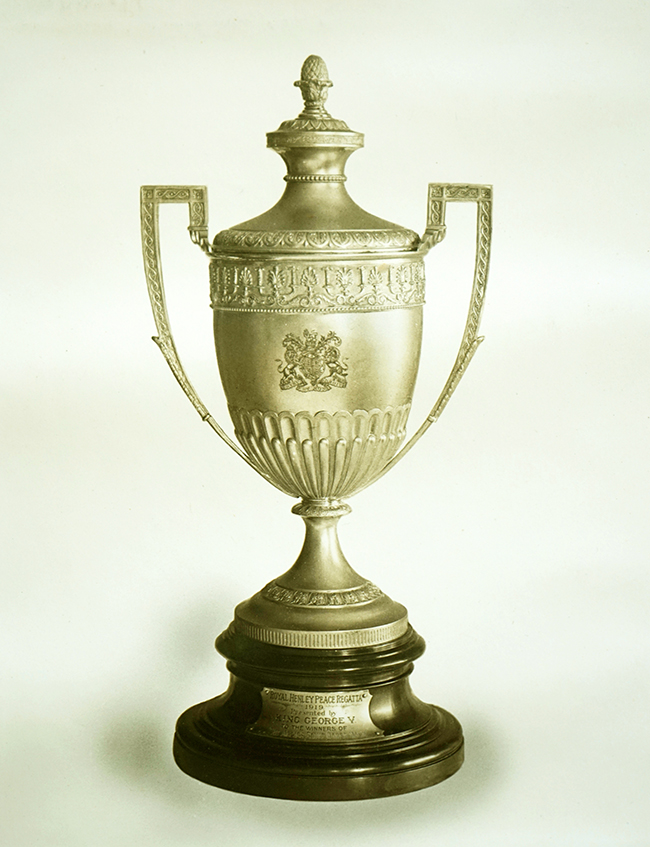
The King's Cup in 1921
The story of the gaining of the King's Cup as the perpetual trophy for the men's interstate eight oared championship of Australia is one of the great Australian sports stories and is covered elsewhere.
Following the cessation of war in 1918, wartime authorities created diversions for war weary soldiers who needed activities as they waited for up to two years for transport home. The recovery from the ravages of war through sport became a significant benefit of these activities. The selection processes for the Henley Peace Regatta and the Inter Allied Games had the added difficulties of locating, gathering, maintaining and dealing with men recovering from the rigors of war. The role of sport in this time was aptly reported by the Daily Telegraph on 25th March 1919: "It is now the turn of sport to win the Peace."
To complicate matters more, war-hardened soldiers demanded coaches to coach them in the style they had been used to before the conflict. In the end, they enjoyed tough racing, and then success in winning the King’s Cup at the Henley Peace Regatta, the regatta at which they all sought to race.
The story did not end there. War time authorities sought to keep the King’s Cup as a trophy of war. The rowers and astute administrators of the time had other ideas.
Given that there was no national rowing association, the Victorian Rowing Association, and in particular Edward Kenny, took the lead in the fight. When all avenues were lost, Kenny prepared a petition to the King signed by the stroke of the AIF No 1 crew who won the trophy at the Henley Peace Regatta in 1919, Clive Disher, asking the King to over ride his advice from his Ministers and give the Cup to the rowers. The petition politely stated that 5000 Australian rowers fought for him in WWI and implicit in this request was that this gesture was a minor request in return.
Given the sacrifices, the request could not be denied, and eventually confirmed by the Secretary of State for the Colonies, Winston Churchill. The story, and the recognition of rowers who served in WWI, will continue, in perpetuity, as the states battle to win this prized trophy each year. Some quotes from prominent rowers 100 years on in 2019 summarise the important of the King's Cup.
The King’s Cup holds a special place in the hearts of Australian rowers. The fierce rivalry, tribal elements and intensity of racing make it a most coveted trophy. It’s also an annual reminder of the 5,000 rowers who served in WW1, and the fighting spirit of the winning AIF crew in 1919 that is an inspiration not only to rowers but all Australians —Robert Scott, President Rowing Australia
It’s hard to imagine being in the first King’s Cup; the horrors of the war still fresh, the sacrifice of so many soldiers—and then the joy of the Peace regatta. The King’s Cup creates a deep sense of history, rivalry and camaraderie. This elevates the racing and—in my view—is the match of any Olympic regatta. The King’s Cup simply inspires. —Drew Ginn, Triple Olympic Champion and Multiple King's Cup winner
There is no greater celebration in Australian sport than to honour the bravery, camaraderie and spirit of our AIF and to compete resolutely for their King’s Cup with your crewmates —Michael McKay OAM, Dual Olympic Champion and 13 time King's Cup winner.
The Ladies Championship was again raced at the Henley-on-Maribyrnong carnival on Saturday 5th February 1921 with Dimboola taking the honours for the first time. Dimboola was successful despite being invited a few weeks prior and not having trained since the Dimboola Regatta the previous November. The Argus report on Monday 7th February 1921 had an interesting aside. The visiting English cricketers attended the regatta. In his speech at the regatta conclusion, the Mayor issued an open invitation for English women's crews to visit. The mayor (Councillor Royle) referred to the success of the women's rowing crews from Dimboola and issued a challenge to similar crews in England. The English teams could come to Melbourne, or, if the challenge were accepted, enough money could be raised in Essendon to send the Dimboola women to England. (Applause.)9
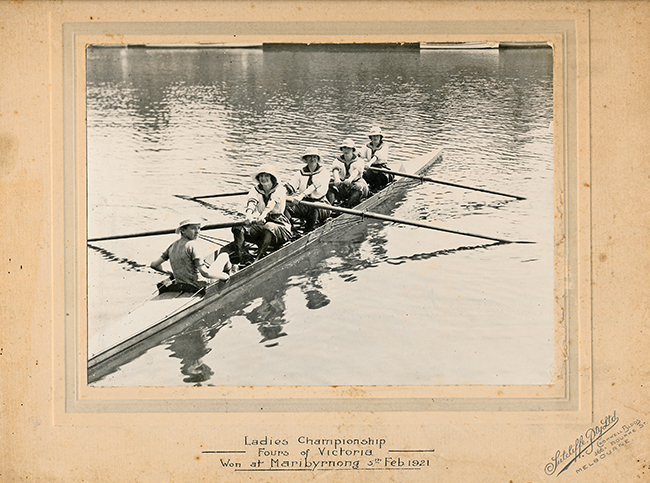
Victorious Dimboola Four
Bow: N Purcell, 2: H Harboard, 3: P Walsgate, Str: Val Hunter, Cox: L Emery
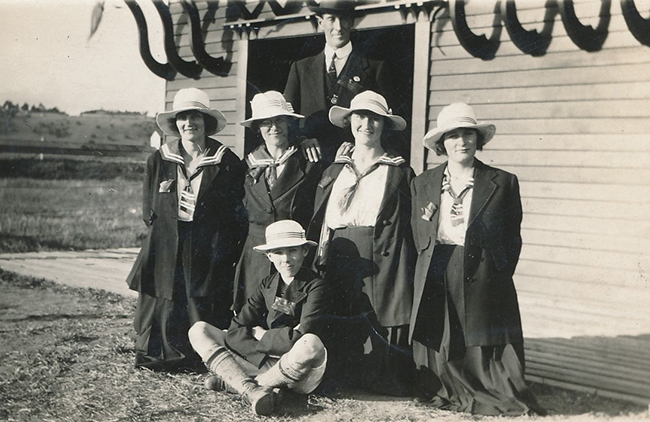
The victorious Dimboola Four with coach
1922
Some extracts from the Victorian Rowing Association annual report follows.
All members of the Victoria Rowing Association could happily agree that the sport of rowing in the state was firmly re-established on its pre-war basis, membership levels and regatta entries were the highest in the history of the Association.
The race for the Australian Eight-Oared Championship was held over three miles on the Parramatta River in May. All members of the crew were representatives of Mercantile Rowing Club, this was the first occasion that the state was fully represented by a club crew. The crew was coached by Mr A B Sloan, and in a superb performance finished second to the powerful South Australian crew. This second place finish was the best the state had seen since they were victorious in 1912. Through the courtesy of the authorities of the North Shore Church of England Grammar School the crew resided at the School’s fine boathouse at Gladesville.
Interestingly, before the Victorian Eight left for Sydney the Ballarat Regatta Association, on behalf of the three Ballarat Rowing Clubs, issued a challenge to the crew with a view to the winners of the challenge race representing the state. This challenge was not entertained, as it did not admit the right of any club or combination to challenge the crew selected by the Selection Committee.
-o0o-
The Ladies Championship was again conducted as part of Henely-on-Maribyrnong Carnival on Saturday 18th February 1922. Despite threatening weather and growing pollution in the river, the carnival continued to improve and gain prominence. The Championship race was an all Albert Park affair after Bendigo withdrew after entering.8
1923
The women's four oared Championship was again conducted at the Henley on Maribyrnong Regatta held on 10th February 1923, this time gaining an interstate entry.
The Argus reported on the race as follows:
Keen interest was displayed at the Henley on Maribyrnong regatta on Saturday in the women's races. There were two heats and a final in the championship fours. A crew from Sydney (D. Sargent bow, B. Bagley 2, L. Pike 3, and C. Martin stroke) was beaten by a canvas by Albert Park No. 2 crew (B. Hood bow, V. Sampson 2, R. O. Sullivan 3, and E. Connor stroke); and Bendigo (A. Croker bow. J. Hesse 2, L. Walker 3, and J. Wrigley stroke) beat the Albert Park No. 1 crew (S. Casey. H. Elmore, 0. Jensen, and C. Murphy) easily. The final was a splendid race, and Albert Park won by a foot.10
The Albert Park No 2 crew was selected to represent Victoria in the third Interstate Women's Four Championship, thus becoming Victoria's first representative women's crew at these Championships.
1924
Victorian Ladies Clubs began affiliating with the Australian Women Rowing Council from 1921, a year after the formation of this national body. However, it was not until 1924 that the Victorian Ladies Clubs formed their own Association on Thursday 7th February 1924.
The best evidence that we have of this commencement date, is an article in the Emerald Hill 'Record' of Saturday 9th February 1924 as follows:
LADIES' ROWING NOTES.
On Thursday evening a meeting was held in the Albert Park Ladies' Rowing Club boat house to organise a Victorian Ladies' Rowing Association. The meeting was well attended, representatives from the following clubs being present — Essendon, Preston, Bendigo, and Albert Park. Miss Pilkington, of the Albert Park club, was elected secretary pro tem, and Miss Lakeman, of the Preston club, assistant secretary pro tem. The next meeting will be held during Easter week, as arranged, when nearly all the clubs will be in town, or their representatives. Notices are to be sent to all the ladies' in Victoria. The main business to be done will be to elect office-bearers and draft rules.
In all probability Bendigo will represent Victoria in the next inter state race which is to be rowed in Adelaide. Accompanied by a large company of friends, Albert Park oarsmen attended the Essendon regatta on the Maribyrnong last Saturday afternoon. Albert Park and Bendigo crews were both winners in the ladies races. The championship fours were rowed in heats. The second heat was won by Albert Park, after a very fine race, from Essendon. It was the first appearance of the Essendon Ladies' Club, and they rowed very well. In the finals for the championship Bendigo beat Albert Park. The Maribyrnong fours were rowed, only two ladies' crews competing in this. They were Preston and Albert Park, both junior crews. This contest proved a win for the Parks.
It is always difficult to pin point an exact date of formation given there was no legal or incorporation steps in those days. The same local newspaper reported on 8th March 1924 that Miss Parkington is working very hard in connection with the formation of a Victorian Lafdies' Rowing Association. It could be argued that the formation date was after the 7th February 1924 and probably 1st May 1924.
The triggers for this decision could have been many fold. Many reasons were no doubt building up over the years. The fact that other States had formed their own women's Associations, that Victoria had a men's association, that the organisation of Victorian championships needed more thorough consideration, or simply that the Victoria was to host the 1925 Interstate Championships in 1925. The reasons for the delay would have been that the Australian Ladies' Rowing Council allowed direct club membership, there was consensus on the organisation of the Victorian Championship four and the selection of the Victorian four as the winner of the Victorian crew provided that they paid their own way, and there was no reason to add a layer of administration on a small number of clubs.
The impending hosting and organisation of the Australian Championship in 1925 and the opportunity to raise funds from it, provides the most likely trigger for the formation.
The Emerald Hill "Record' of 10th May 1924 provides some evidence towards this conclusion. On 1st May 1925 a meeting was held in conjunction with a social event hosted by Albert Park Ladies Rowing Club and reported in the Record (Emerald Hill) on the 10th May 1924. The relevant part of the article is as follows:
ROWING
Albert Park Ladies' Club.
A social evening and meeting was held in the Albert Park Ladies' boat house on Thursday, last, May 1. The meeting occupied the first part of the evening; it was in connection with forming the Victorian Ladies' Rowing Association, representatives from Sydney, Bendigo, Preston, and Albert Park clubs being present. It was decided by the conference held in South Australia after the championship of Australia had been rowed, to hold the race in Melbourne next year. This race will be rowed on the Albert Park Lake about April of next year, and the profits are to go towards the Victorian Ladies' Rowing Association. A musical evening followed.
In summary from these two articles, we have
- adopted Thursday 7th February 1924 as the commencement date of the Victorian Ladies' Rowing Association,
- named the original member clubs of the new Association as Albert Park Ladies', Bendigo Ladies', Essendon Ladies' and Preston Ladies Rowing Club,
- the person most likely to be the driver of the formation was Miss Pilkington of the Alert Park Ladies' Rowing Club as the initial secretary and convenor of the first meeting; and
- used the hosting and thus organisation of 1925 Interstate Championship as a material driver for the formation of the Association at this time.
[As an aside, there was an article in the Argus on 13 February1922 which referred to the 'VLRA' as running their Championship Four race that year but this reference to a non-existent organisation at that time is considered to be an error.]
Despite this conclusion, an article in the Melbourne Herald on Wednesday 23rd July 1924 refers to the recently formed association, the cups presented for competition and the 2024-25 office bearers. So the author's conclusion is far from certain.
The 1924-25 season office bearers were:
President - Lady Tallis
Vice-Presidents - Mrs W Brunton Lady Mayoress of Melbourne, Mrs Bartrop Lady Mayoress of Preston, Mesdames Crockford, Wallace, Float, R Williams, Charles Donald, Suffolk, Frank Brennan, Jensen, Fitzgerald
Hon Secretary - Miss Lena Partington
Hon. Treasurer - Mrs Williams
Given Lena Partington's early work of getting the Association formed and her role as the first Hon. Secretary both pro tem and permanent, one can only assume that she had a significant role in the VLRA formation.
The Ladies Championship was as usual conducted as part of the Henley-on-Maribyrnong Carnival and again heats were required.11 Four Clubs competed with the final won by the Bendigo Club from Albert Park with a one length margin. The Bendigo crew gained selection as the Victorian crew as a result.
1925
The highlight for the women this year was the hosting of the Interstate Women's Four Championship on Albert Park Lake on Saturday 18th April 1925. The following report by the local South Melbourne paper (the Emerald Hill 'Record', Saturday 25th April 1925 page 7) focussed on the local races. But what the article does show is how well the organisers made a carnival out of the regatta.
They clearly gained the imagination of local dignatories and public alike. The local dignatories raced and played to their egos by giving them duties to perform. Mixed races were also undertaken much to the enjoyment of the naval contingent present. The public were given a fly past by the airforce, a naval attachment turned out, the South Melbourne City Band and Port Melbourne Naval Band joined in a programme of music, and of course, there was the Championship racing. We should take lessons from our forebears on how to run a rowing carnival.
Municipal Head of the Lake
Won Handsomely by South Melbourne crew.
In the presence of a goodly number of people the Victorian Ladies' Rowing Association's regatta - with the Interstate Women's Fours Championship as the central event— was held on the Lake on Saturday afternoon.
While the weather was fine with a bracing autumn breeze, from the many spectators' viewpoint the wind was not a favorable element, as rowing people saw it, as it blew almost dead against the bows of boats in the races.
A ceremonial part of the reunion had for its central attraction the unfurling of a flag over the A.P.L.R.C. clubhouse, to commemorate the circumstance that it was the first rowing carnival organised by the association. Seeking a good-looking man to release the pennant, the rowing girls chose the Mayor (Cr. Murray I. Jones) for the task. With a little chain of compliments on the graces of the fair sex and allusions of admiration for oarswomen, the Mayor gracefully performed his commission. The distinction of having his patronage courted by the ladies made Cr. Murray Jones at once the envy of all the other men present, especially the public representatives. Among the latter were Crs. Floate and Page, Mr. A K. Wallace, M.L.A., the Mayor of Brunswick (Cr. F. T. Wimpney), Cr. Fitzgerald (a visiting civic dignitary), as well as Mr. E. C. Crockford (S.M. town clerk), Cr Layfield and Cr J. Jensen. Although socially a big figure in South Melbourne, Cr. Jensen's public activities are centred in Portarlington.
With Miss Latchford taking a customarily energetic part in perfecting the arrangements, in conjunction with a party of rowing girls and a committee of local residents — both ladies and gentlemen — the programme was put through with despatch.
After the air wing of the Commonwealth Defence Force gave a highly spectacular touch to the proceedings with a flight by a sea plane, altitudinally and colorfully, the public was invited to turn its eyes on the local Council's crew announced to row against the Corporations of Brunswick and Essendon. With the assistance of a big following of eager suporters, Crs. Shippen and Guy were squeezed into red and white oarsmen's 'togs' to row for the fair fame of South Melbourne, along with Messrs Hiscock (the assistant city engineer) and W. Marshall (of the Town Hall staff). A councillor volunteer was called for cox. Mr. C. Short was made a representative of 'Lake' Ward, proclaimed for the occasion. It was related afterwards that Cr. Layfield nearly knocked 13 persons down in a rush to get on a soap box to back the South Melbourne four, against the world. One opposing crew timidly faced the local stalwarts only to be handsomely beaten, 'Cr.' Short bringing his invincibles home winners, and almost lifting the boat out of the water with every stroke.
As the interstate oarswomen were taking to their outriggers to race for their cup, most of the men found themselves, for want of a crew of Albert Park girls to admire, compelled to transfer their affections elsewhere. The Mayor ventured an opinion that the Sydney girls would win the cup. Cr. Layfield, on the other hand, was a strong barracker for South Australia. The race very elegantly confirmed the judgment of the energetic representative of Normandy. The South Australian crew by brilliant rowing in a splendid race won a dashing style. The other States represented were Victoria, New South Wales, and West Australia.
Along with South Melbourne City Band, Port Melbourne Naval Band joined in a programme of inspiriting music. A big naval detachment turned out, no doubt to see officers of theirs rowing in mixed fours with oarswomen. This looks very, very romantic.
Other events resulted: — Novice Canoe Pairs :— Final : Twickenam No. 1 defeated No. 2 by four lengths. Y.W.C.A. Skiff Race:— Final: Columbines (Misses Clifton and Johnson), 1 ; Hoorars, 2; Pioneer, 3 ; Boomerang, 4. Women's Combined Fours: — Final: Misses Rimmer, Thomas, Cholet and Notley defeated Misses Mounsey, Cross, Bell and Elder by two lengths. Women's Club Fours : — Final : Albert Park, 1 ; Essendon, 2, Mixed Fours : — Final: Misses Sennitt and Casey, with Messrs. Paxton and Nettlesold, defeated Misses Connor and Wheeler, with Messrs, Fisher and Annable, by two feet.
The proceeds of the regatta were in aid of the Children's Hospital, the V.L.R.A., and the Lake Improvement Society. Miss I. Partington was secretary, Mr., E. Crockett, assistant secretary, and Mrs. Williams treasurer.
Presentation of Trophies.
Trophies won at the regatta were presented to the winners on Monday night by the Mayor at a dance held by the local ladies' rowing club. The Mayor said he wished to congratulate the oarswomen responsible for the organisation of the regatta upon their capable efforts. He was looking forward to seeing the lake the scene of many more similar spectacles. The visitors had shown great enterprise in travelling so far to take part in the annual event, and their coming to Albert Park was a compliment to South Melbourne. The crew from the Torrens had retained the interstate cup by a brilliant effort in a splendid race. (Aplause.) Cheers were given for the visiting crews. The challenge cup, which the South Australian crew succeeded in holding, was presented by the Queensland Licensed Victuallers' Association for competition in 1920. Miss Latchford, captain of the Albert Park crew, said the Licensed Victuallers' Association in the State in which the championship was held presented gold medals to the winning crew.
The club deeply regretted the cause of the absence of the president of the Victorian Ladies' Rowing Association, Mrs Knight— the death of her husband, the late Cr. F. G. Knight. Trophies, the gift of Messrs. Steele and Co, of Swanston street, were presented to the S.M. Councils crew, which won the 'municipal head of the lake.'
It was a splendidly organised rowing carnival.
Prior to this event, the Victorian Ladies Champion Fours were conducted as usual at Henley on the Maribyrnong, this year on 7th February 1925. Bendigo took the honours from Albert Park Ladies by half a length.
1926
The Women's Four Championship was again conducted as part of the Henley on Maribyrnong carnival although the newspaper reports did not title the race the championship. It was again won by Bendigo from Preston by 2 lengths.
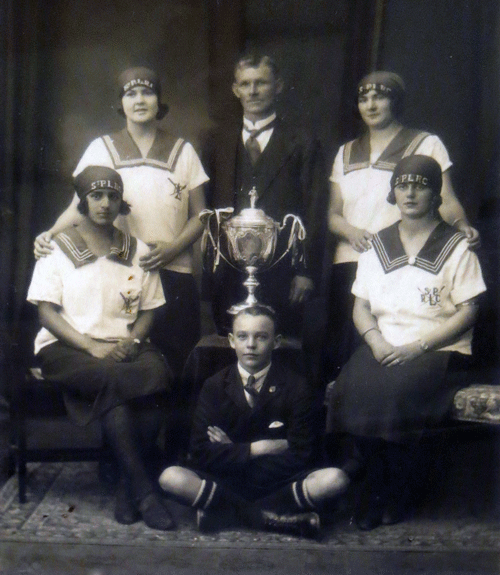
The victorious Bendigo Women's Four from St Paul's Ladies Rowing Club
Back row: Edna Goddard (2), Davis Wilson (coach), Nell Dodd (3). Front row: Violet Clifton (stroke), Bill Parkinson (cox), Ada Green (bow)
1927
1928
Championship racing
The Albert Park Ladies’ Rowing Club were successful again on the Ladies senior race at Henley on the Maribyrnong. The winning crew was: D. Brooks (stroke) I. Ludlow, J. DeZoete, E. Murphy (bow), E. Cross (cox) and P. W. Fisher (coach).
As an aside, The Record of Saturday 11th February, 1928 reported that unfortunately, the Park [Albert Park] Junior Four, consisting of V. Sampson (stroke), K. Sampson, E. Jackson, M. DeZoete (bow) was disqualified for arriving late to the start line, due to an engine failure in the motor boat, which was towing their boat to the starting post.
The Princes Bridge Boat Staging 1912-1927
All rowing clubs face the perpetual issue of a boat staging unless they are fortunate that their boating area is situation on a waterway with a sand covered, beach style, gradual embankment. Very few areas offer such a natural and pleasant access.
The Yarra River, with it's excessive silt, strong currents and flooding, has always required a sturdy staging.
The original stagings were private and built by the resident boat builders and no doubt required much repair after each flood. As most Princes Bridge clubs boated from the boatbuilders boatshed, and many suburban clubs rented rooms from the boatbuilders during the racing season, these private arrangements worked well.
Later in the nineteenth century, clubs were beginning to build their own sheds at Princes Bridge and elsewhere and this complicated the issue.
The following story provides an insight into these staging issues and also highlights the impacts of the twentieth century World Wars on civic infrastructure. The information is sourced from a voluminous Rowing Victoria file and is interesting.
On 22nd of August 1912, Ted Kenny, as Honorary Secretary of the Victorian Rowing Association, wrote to the Secretary of the Department of Works seeking their assistance with the rebuilding of the staging. "At the present time it is in a very dangerous condition and as the beams are not sound enough to hold a nail it is practically beyond repair." Interestingly, the clubs and boatbuilders offered to pay 8% of the cost pa to cover the interest on the cost of the construction and also ongoing maintenance of the staging. On 12th February 1913, the Secretary of the Department of Public Works disputed the assessment of the state of the staging, undertook to repair parts of the staging, and advised that the government did not have the 400 pounds required to rebuild it. John Lang, on behalf of the Association, lobbied the Minister (in 1913 called "interviewing" the Minister) without success.
The Melbourne City Council also agreed to undertake some temporary repairs but without taking any liability for the staging. Whilst all this was occurring, World War 1 commenced and all focus and money was devoted to the war.
By mid 1914, a committee titled The Alexandra Park Committee (controlled by the Melbourne City Council), which was responsible for the maintenance of the river banks above the high water mark, was asked to consider the future maintenance and control of the staging and met with Messrs. Kenny and Lang of the VRA. The Committee has no funds and was also reluctant to fund infrastructure which was used by only rowing clubs and boat builders.
Realising that the clubs would have to lead the initiative, in the same manner as clubs in other areas of the State, the VRA proposed that the Clubs and the Henley Committee contribute but on the condition that the boatbuilders bore most of the cost. In a lengthy report back to the VRA Committee of October 1914, Kenny and Lang made this recommendation, which the VRA Committee accepted. However, neither the Henley Committee nor all Princes Bridge clubs agreed with this solution and matter was carried forward into 1915, then 1916. By September 1916, the VRA sought from The Alexandra Park Trust for their estimate of the annual maintenance cost of the staging and an amount for a sinking fund for replacing the staging in due course. The VRA proposed that they would then allocate the cost to the various parties. The Trust agreed to provide the information requested and in January 1917 advised that 50 pounds pa for both maintenance and a sinking fund would suffice.
Again this idea failed by May 1917 due to disputes about the allocation - with the clubs happy to pay 25 pounds pa but the boatbuilders refusing to pay their share, their businesses having come to a standstill due the war. The VRA concluded that the matter be held over until the end of the war.
However yet another twist in the story arose with the Lands Department handing over responsibility of the boatshed area to The Alexandra Park Trust from 1st July 1917 and all rents would thence forward be paid to the Trust along with the new 50 pounds pa staging charge. The VRA was asked for their views on the allocation amongst the interested parties and responded that 25 pounds be allocated equally between University, Yarra Yarra, Banks, Richmond, Mercantile, Melbourne and Civil Service clubs, and the other 25 pounds allocated to boat builders be charged in proportion to the rent paid by them. No Henley Committee contribution was considered. Furthermore the Alexandra Park Committee reduced the first year payment to 30 pounds but asked that the VRA collect the money on their behalf. The VRA declined their request but in the end attempted to do so. VRA Hon, Secretary Ted Kenny recorded in a private note to John Lang his complaint about the correspondence, telephone calls and discussions involved, "and I reckon they owe me a pair of boots for the running about I have had in collecting the money." He added that he had no luck in getting Greenlands to contribute. John Lang personally paid for the University contribution given the slow response from University.
The same fee was charged for the next few years and the VRA again was the collector. The Council gradually took over the collection of non-affiliated Clubs prompted by Melbourne Rowing Club disaffiliating from the VRA, Melbourne Grammar School building their own boatshed, and the boatbuilders losing their tenants.
By 1921, even the Melbourne City Council agreed that the staging was in a dangerous condition with the sub-structure failing, and needing to be replaced. Even though the sinking fund had grown to 111 pounds, contributions from the now eight clubs and two boat builders needed to be increased to 10 pounds pa. And further increases followed. As expected there was much debate around the nature of the staging.
It was still not until 1927 that the staging was replaced with concrete footings and jarrah wooden structure at a total cost of 2,157.5 pounds. The funding came from the sinking fund of 430 pounds, a contribution of 700 pounds from the Henley Committee and further contributions from the Clubs of 904 pounds. The staging was built. The balance of 123 pounds was eventually paid by the Clubs. Even during construction, complications of the extent of the staging changed with Richmond Rowing Club being granted a site west of Melbourne Rowing Club which required an extension of the staging westward to cover this new site.
So after an enormous amount of effort, the Princes Bridge Clubs had a new staging in 1927, some 15 years after the urgent matter was raised.
A similar story of delay arose in the building of the Swan Street Bridge across WWII - more on this later.
Footnotes
- Victorian Rowing Association annual reports
- Sourced from the Rowing Victoria staging file read by the author in December 2023
- LADIES ROWING NOTES. (1924, February 9). Record (Emerald Hill, Vic. : 1881 - 1954), p. 7. Retrieved June 24, 2024, from http://nla.gov.au/nla.news-article162535987
- ROWING. (1924, March 8). Record (Emerald Hill, Vic. : 1881 - 1954), p. 2. Retrieved June 24, 2024, from http://nla.gov.au/nla.news-article164442143
- ROWING. (1924, May 10). Record (Emerald Hill, Vic. : 1881 - 1954), p. 2. Retrieved June 24, 2024, from http://nla.gov.au/nla.news-article164449349
- Competition for Mothers Rowing Association Formed (1924, July 23). The Herald (Melbourne, Vic. : 1861 - 1954), p. 12. Retrieved July 30, 2024, from http://nla.gov.au/nla.news-article246164856
- HENLEY ON THE MARIBYRNONG. (1920, February 16). The Argus (Melbourne, Vic. : 1848 - 1957), p. 9. Retrieved July 31, 2024, from http://nla.gov.au/nla.news-article1677617
- Henley-on-Maribyrnong. The Age Monday 20 February 1922, page 5
- MARIBYRNONG CARNIVAL. (1921, February 7). The Argus (Melbourne, Vic. : 1848 - 1957), p. 5. Retrieved July 31, 2024, from http://nla.gov.au/nla.news-article1735553
- WOMEN'S SPORTS. (1923, February 12). The Argus (Melbourne, Vic. : 1848 - 1957), p. 3. Retrieved July 31, 2024, from http://nla.gov.au/nla.news-article1875310
- Henley on Maribyrnong, The Age, Monday 4th February 1924 page 13
< previous Chapter 6
> next Chapter 8

